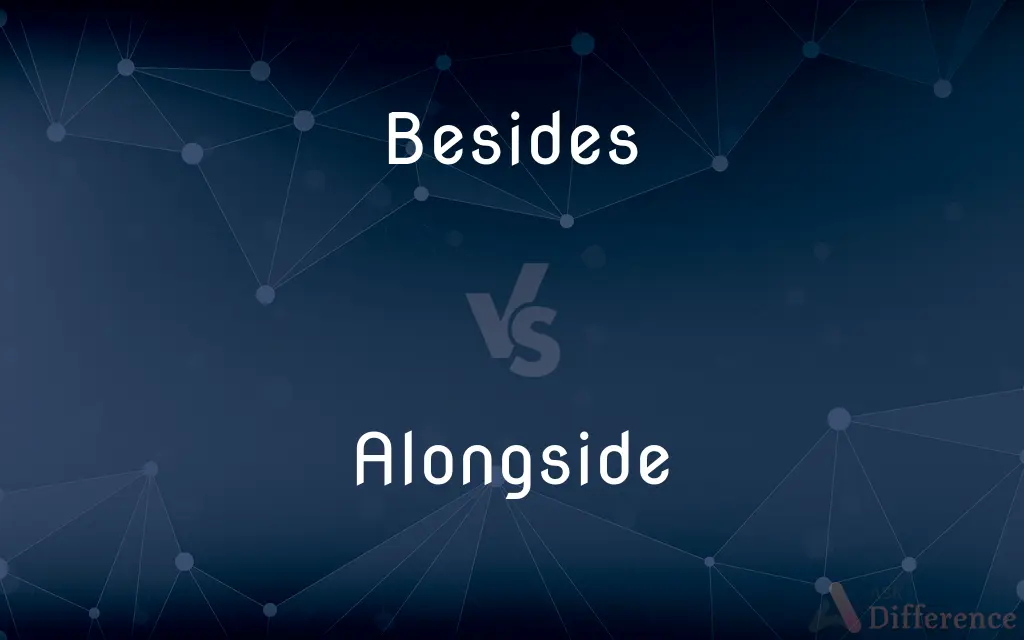Besides vs. Alongside — What's the Difference?
By Tayyaba Rehman — Published on October 19, 2023
"Besides" can mean in addition to or apart from, and "Alongside" primarily refers to the position next to or together with. They vary in indicating positional relation and additional aspects or alternatives.

Difference Between Besides and Alongside
Table of Contents
ADVERTISEMENT
Key Differences
"Besides" and "Alongside," while sharing an implication of proximity or addition, are distinctly applied in contexts. "Besides" often conveys an idea of ‘in addition to’ or ‘apart from,’ and it can introduce additional information or alternatives, such as in "Besides mathematics, she is also proficient in science." "Alongside," conversely, predominantly signifies being next to or together with someone or something, emphasizing a physical or metaphorical positional relationship, like "She worked alongside her colleagues to complete the project."
"Besides" carries a multifunctional utility, serving to introduce additional items in a list or present alternative scenarios, enabling the expression of supplementary information or choices. It provides breadth to the conveyed message, allowing the inclusion of diverse elements or options. On the other hand, "Alongside" maintains a more consistent application in representing parallel positioning or partnership, outlining the coordination or coexistence of entities in spatial or conceptual terms, enhancing the depiction of cooperation or simultaneity.
In terms of usage scope, "Besides" extends beyond mere positional indication, enveloping aspects of additionality and alternativity, enriching the narrative by facilitating the incorporation of extra details or possibilities. It broadens the communicative spectrum by offering more comprehensive insights or options. Conversely, "Alongside" remains closely tied to illustrating side-by-side existence or collaboration, refining the portrayal of mutual positioning or joint efforts, reinforcing the sense of shared space or goals.
While "Besides" is versatile in its application, often used to expand or diversify the discourse by introducing more elements or viewpoints, "Alongside" stands firm in its role of delineating concurrent presence or collaboration, underscoring the mutual association or parallelism between the entities involved. Thus, "Besides" opens up the conversation to new dimensions or perspectives, and "Alongside" solidifies the representation of unity or concomitance.
Comparison Chart
Meaning
In addition to or apart from.
Next to or together with.
ADVERTISEMENT
Usage
Introduces additional information or alternatives.
Indicates position next to or together with.
Application
More versatile in application.
Consistent in representing parallel positioning.
Contextual Implication
Can convey additionality and alternativity.
Emphasizes positional relationship or partnership.
Contribution to Narration
Enriches by incorporating extra details or possibilities.
Enhances portrayal of mutual positioning or collaboration.
Compare with Definitions
Besides
Apart from; other than.
Who is going, besides you?
Alongside
Next to; at the side of.
She was standing alongside her brother.
Besides
Serving as an exception or further illustration.
Everyone besides Susan knew about the surprise party.
Alongside
Together with.
They worked alongside each other in harmony.
Besides
In addition to; apart from
I have no other family besides my parents
Besides being a player, he was my friend
Alongside
In company with.
He fought alongside his comrades.
Besides
In addition; as well
I'm capable of doing the work, and a lot more besides
Alongside
At the same time as.
She studied alongside working full time.
Besides
In addition; also
I could smell the ocean, some pine trees, and something else besides.
Alongside
Along, near, at, or to the side
Stood with a bodyguard alongside.
Drove up alongside.
Besides
Moreover; furthermore
I'm too tired to go for a walk. Besides, it's raining.
Alongside
By the side of; side by side with
The boat lay alongside the pier.
Besides
Otherwise; else
Has been to Mexico but nowhere besides.
Alongside
Along the side; by the side; side by side; abreast.
Ahoy! Bring your boat alongside.
Besides
In addition to
She was given a scholarship besides the award.
Alongside
Side by side with.
Besides
Except for; other than
No one besides the owner could control the angry dog.
Alongside
Together with or at the same time.
The nurse worked alongside the doctor.
Besides
In addition, in addition to.
Alongside
Along or by the side; side by side with; - often with of; as, bring the boat alongside; alongside of him; alongside of the tree.
Besides
Other than; except for; instead of.
I don't want to go anywhere besides India.
Alongside
Side by side;
Anchored close aboard another ship
Besides
(obsolete) Beside.
Alongside
Parallel to.
The boat sailed alongside the coast.
Besides
(conjunctive) Also; in addition.
Besides
(conjunctive) Used to emphasize an additional point, especially an important or stronger reason; moreover; furthermore.
I don't feel like going out tonight. Besides, I have to work tomorrow morning anyway.
Besides
Otherwise; else.
I have been to Spain but nowhere besides.
Besides
(obsolete) On one side.
Besides
On one side.
Besides
More than that; over and above; not included in the number, or in what has been mentioned; moreover; in addition.
The men said unto Lot, Hast thou here any besides ?
To all beside, as much an empty shade,An Eugene living, as a Cæsar dead.
Besides
Over and above; separate or distinct from; in addition to; other than; else than. See Beside, prep., 3, and Syn. under Beside.
Besides your cheer, you shall have sport.
Besides
Making an additional point; anyway;
I don't want to go to a restaurant; besides, we can't afford it
She couldn't shelter behind him all the time and in any case he wasn't always with her
Besides
In addition;
He has a Mercedes, too
Besides
Used to introduce something additional.
I don’t want to go there; besides, it’s too late now.
Besides
Moreover; furthermore.
The book is extremely interesting; besides, it’s not too long.
Besides
In addition to.
Besides basketball, he also excels in soccer.
Common Curiosities
Is "Alongside" used to signify positional relationship?
Yes, "Alongside" signifies a positional relationship, illustrating being next to or together with something or someone.
Can "Besides" be used to convey more comprehensive insights?
Yes, "Besides" can convey more comprehensive insights by introducing additional details or possibilities.
Can "Besides" be used to introduce alternative scenarios?
Yes, "Besides" can be used to present alternative scenarios or additional items in a list.
What does "Besides" generally imply?
"Besides" generally implies ‘in addition to’ or ‘apart from,’ introducing additional information or alternatives.
What does "Alongside" primarily refer to?
"Alongside" primarily refers to being next to or together with, indicating positional relation or partnership.
Does "Alongside" emphasize mutual association?
Yes, "Alongside" emphasizes mutual association and parallelism, reinforcing the sense of shared space or goals.
Does "Alongside" indicate side-by-side existence or collaboration?
Yes, "Alongside" consistently indicates side-by-side existence or collaboration, portraying mutual positioning or joint efforts.
Is "Besides" versatile in its application?
Yes, "Besides" is versatile, serving to introduce additional elements, viewpoints, or alternatives in various contexts.
Share Your Discovery

Previous Comparison
Cholecystitis vs. Cholelithiasis
Next Comparison
Bed Sheet vs. Bed CoverAuthor Spotlight
Written by
Tayyaba RehmanTayyaba Rehman is a distinguished writer, currently serving as a primary contributor to askdifference.com. As a researcher in semantics and etymology, Tayyaba's passion for the complexity of languages and their distinctions has found a perfect home on the platform. Tayyaba delves into the intricacies of language, distinguishing between commonly confused words and phrases, thereby providing clarity for readers worldwide.













































